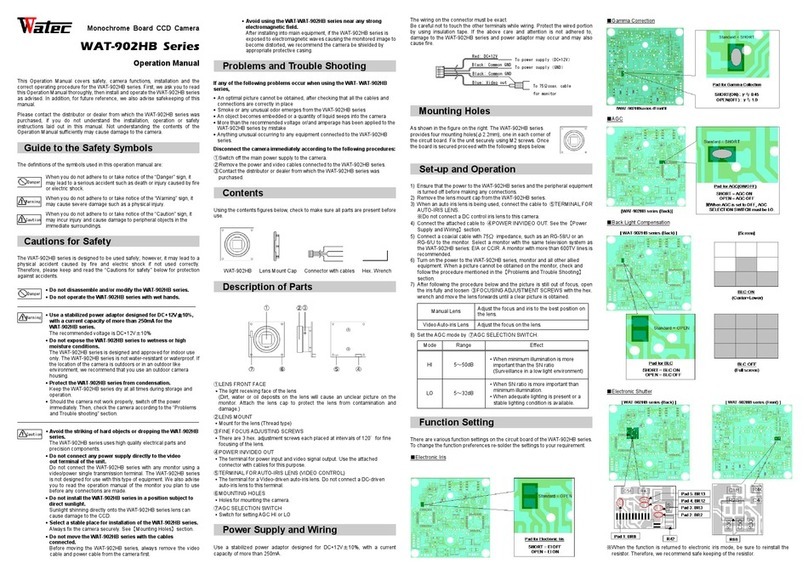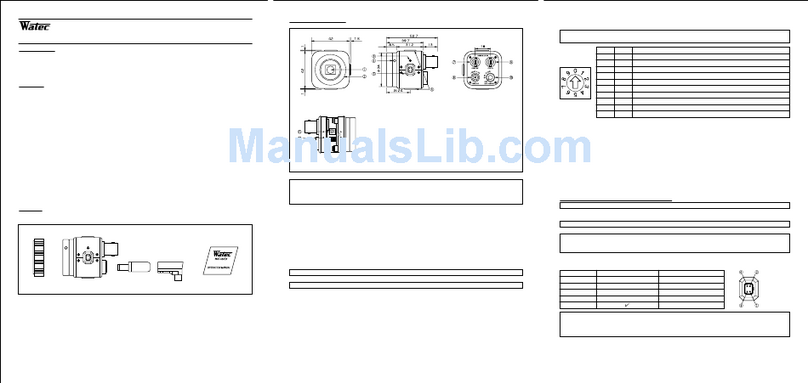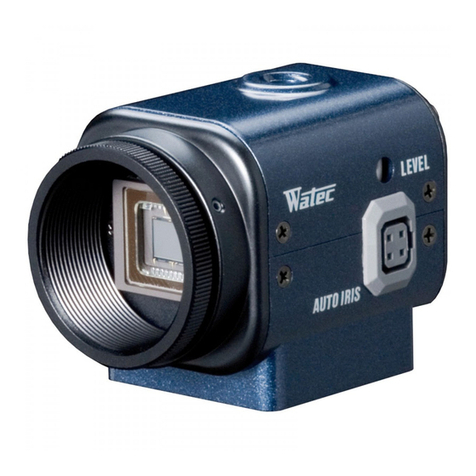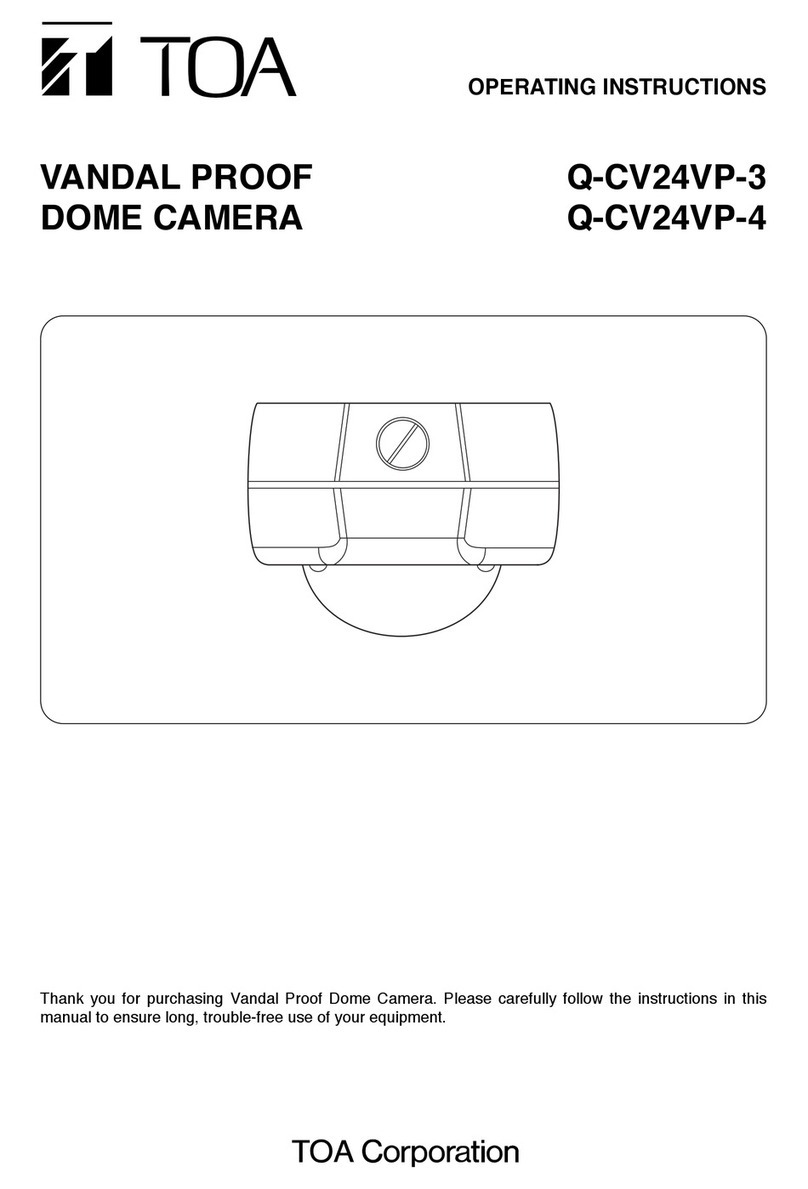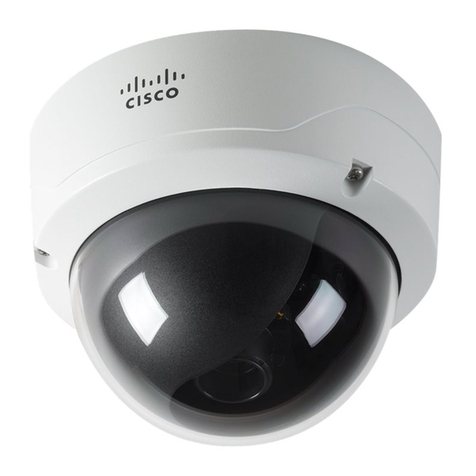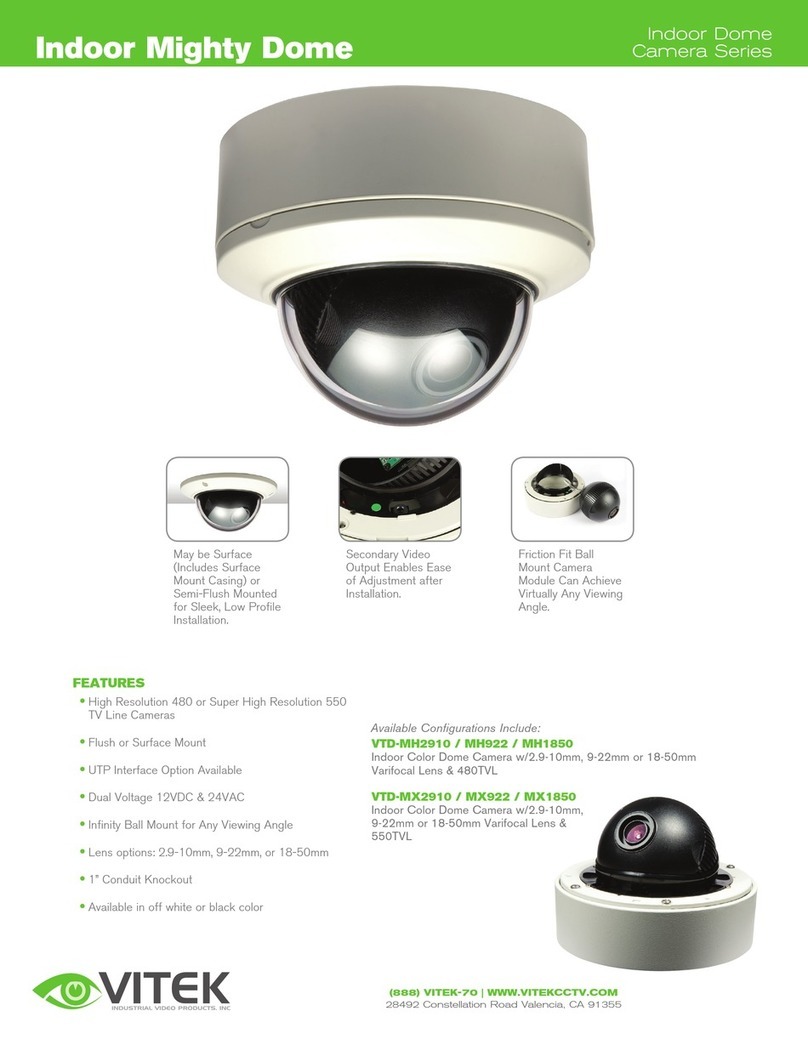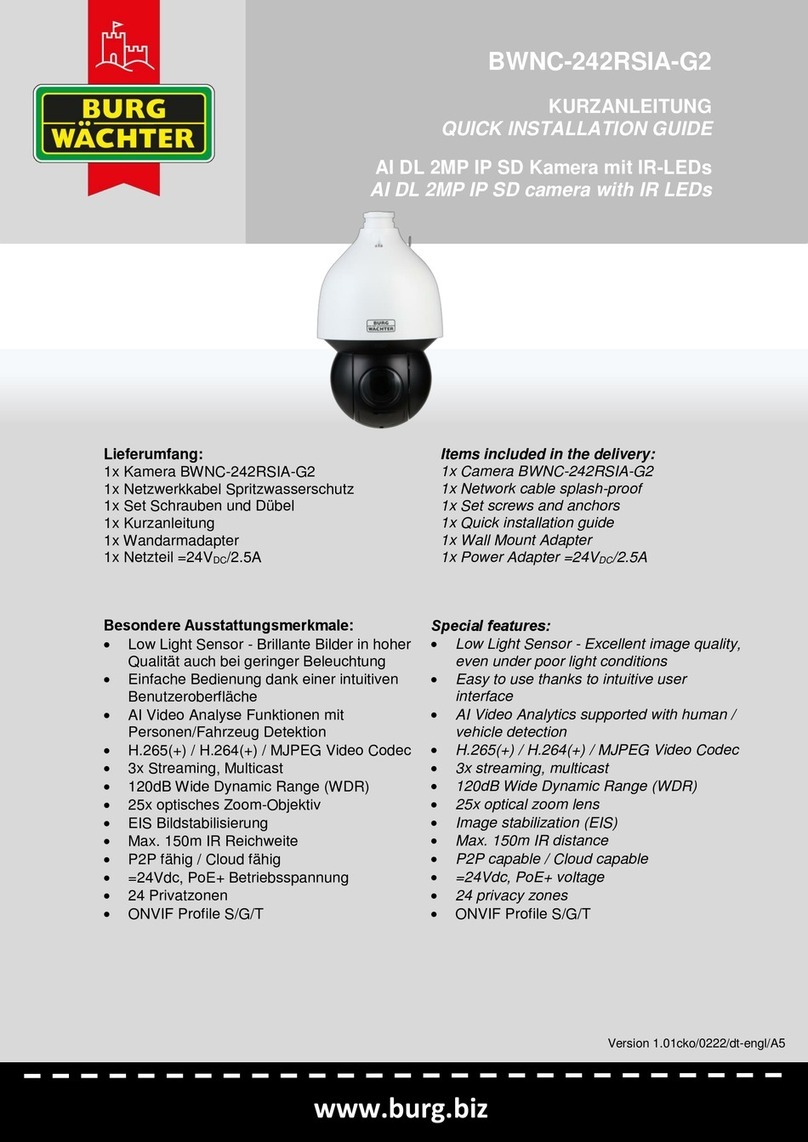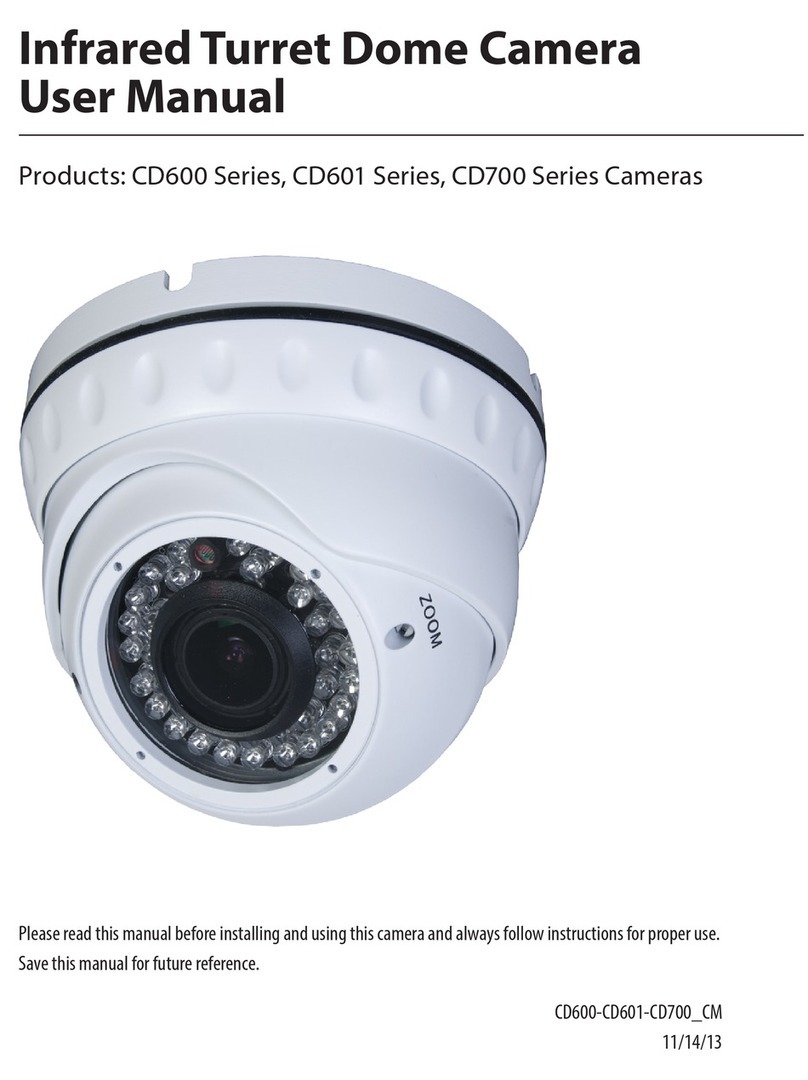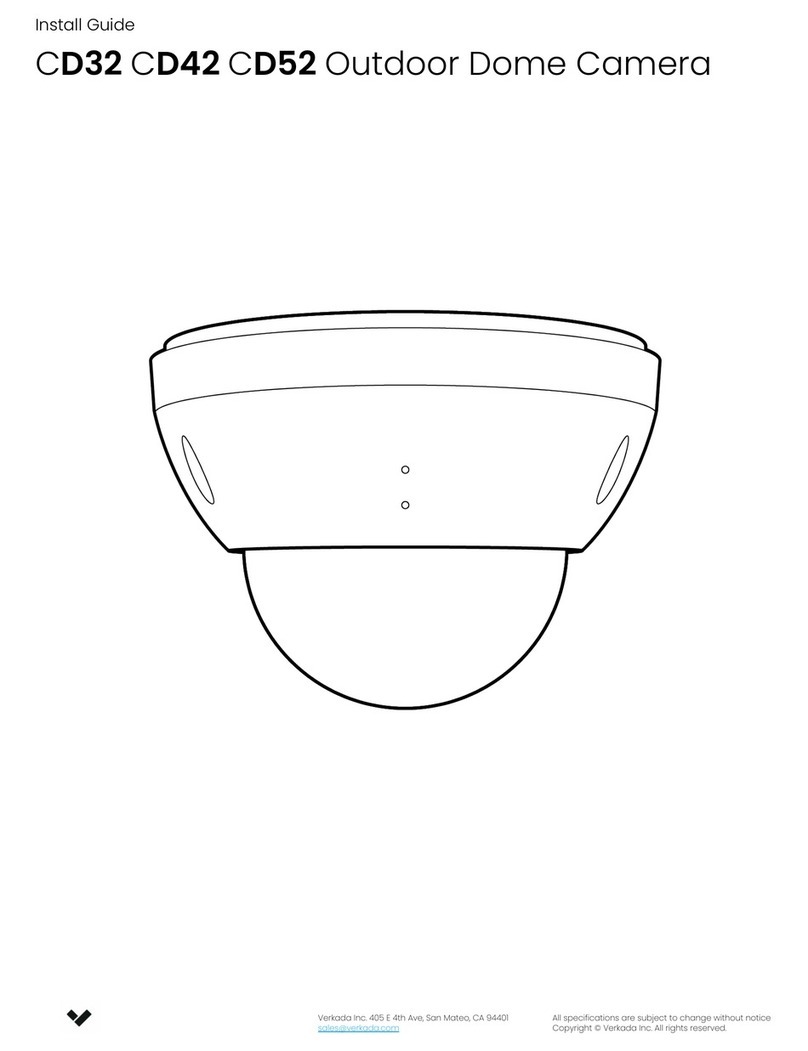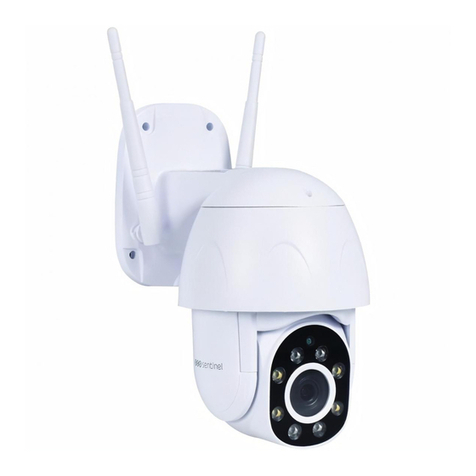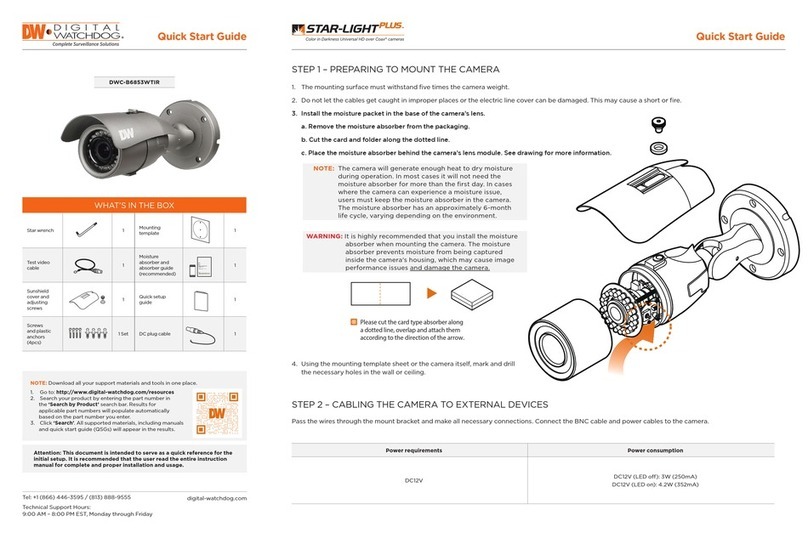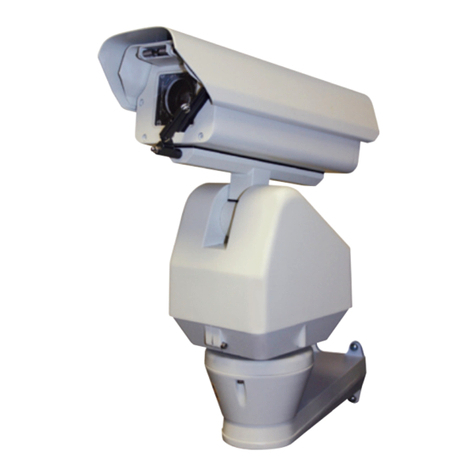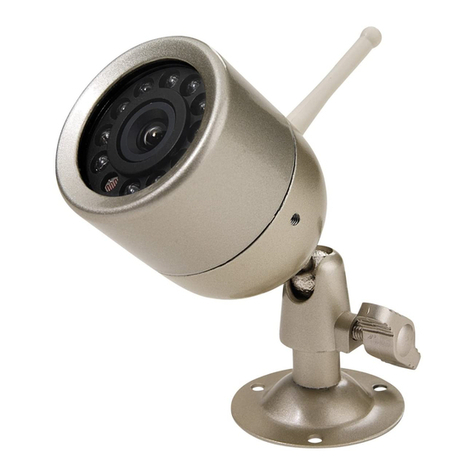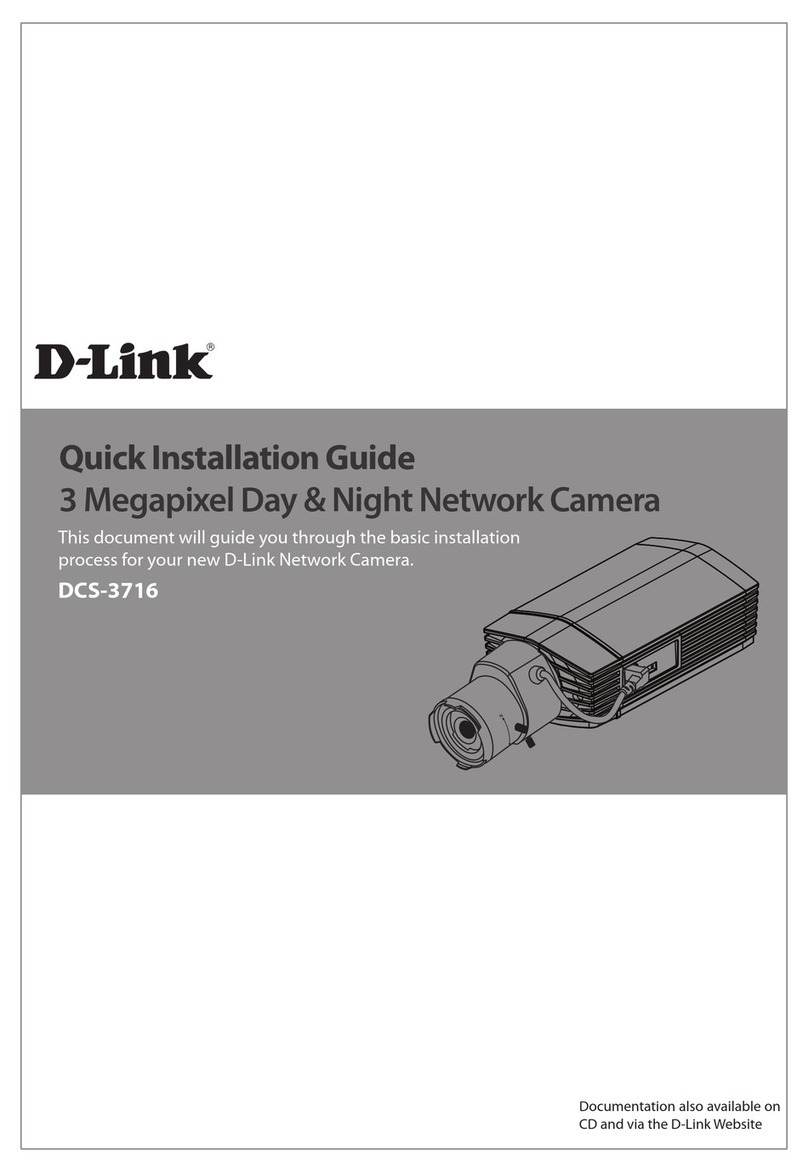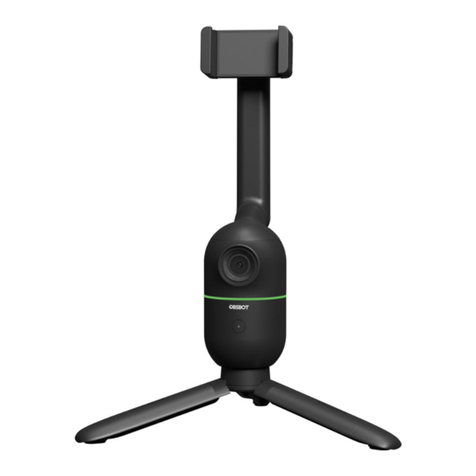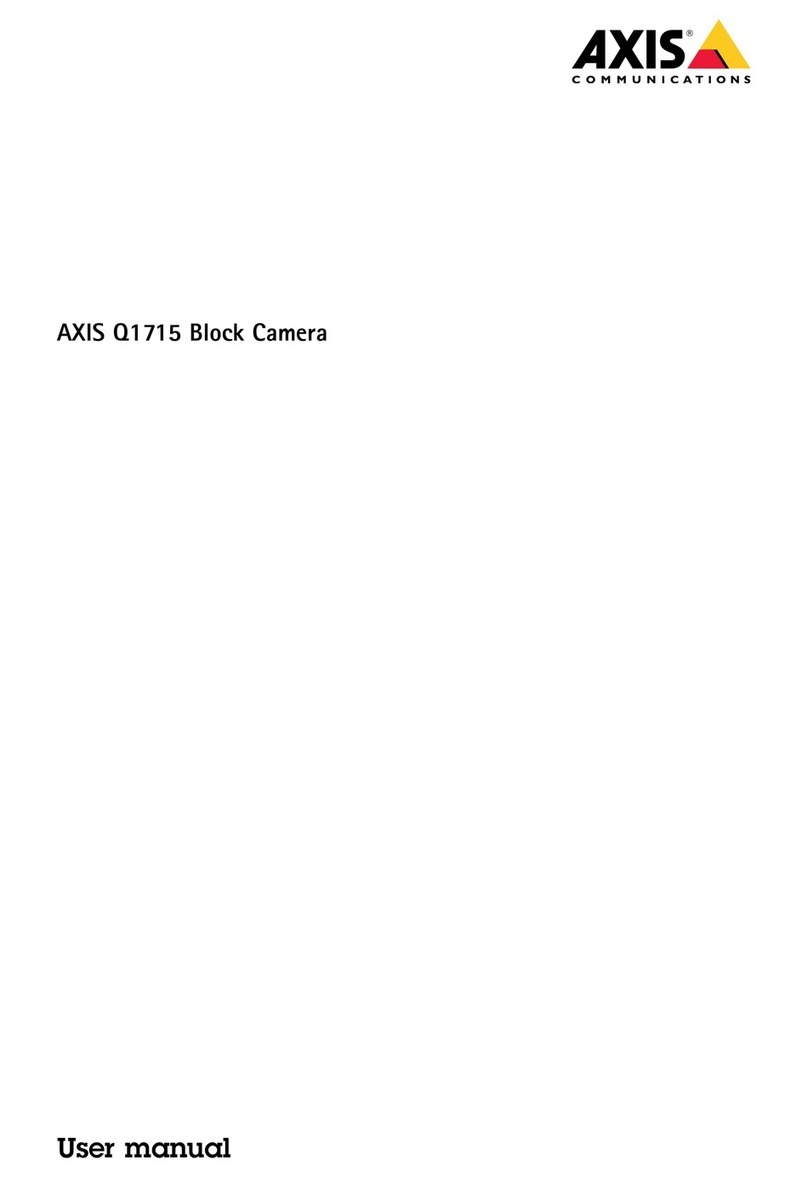Watec WAT-233 User manual

Danger
Danger
Danger
A1(Green)
B1(Green/White)
AC
adaptor
Light sensor
Wide Dynamic Range Camera
WAT-233
Operation Manual
This Operation Manual covers safet , camera functions, installation and the
correct operating procedure for the WAT-233. First, we ask ou to read this
Operation Manual thoroughl , then install and operate the WAT-233 as advised.
In addition, for future reference, we also advise safekeeping of this manual.
Please contact the distributor or dealer from which the WAT-233 was purchased,
if ou do not understand the installation, operation or safet instructions laid out
in this manual. Not understanding the contents of the Operation Manual
sufficientl ma cause damage to the camera.
Guide to the Safety Symbols
The definitions of the s mbols used in this operation manual are:
When ou do not adhere to or take notice of the “Danger” sign, it
ma lead to a serious accident such as death or injur caused b
fire or electric shock.
When ou do not adhere to or take notice of the “Warning” sign, it
ma cause severe damage such as a ph sical injur .
When ou do not adhere to or take notice of the “Caution” sign, it
ma incur injur and cause damage to peripheral objects in the
immediate surroundings.
Cautions for Safety
The WAT-233 is designed to be used safel ; however, if not used safel , it ma
lead to a ph sical accident caused b fire and electric shock. Therefore, please
keep and read the “Cautions for safet ” below for protection against accidents.
•
Do not disassemble and/or modify the WAT 233.
•
Do not operate the WAT 233 with wet hands.
•
Use a stabilized power adaptor designed for DC+12V±
±±
±10%,
with a current capacity of more than 250mA for the WAT 233.
The recommended voltage is DC+12V±10%
•
Do not expose the WAT 233 to wetness or high moisture
conditions.
The WAT-233 is designed and approved for indoor use onl . The
WAT-233 is not water-resistant or waterproof. If the location of the
camera is outdoors or in an outdoor like environment, we
recommend that ou use an outdoor camera housing.
•
Protect the WAT 233 from condensation.
Keep the WAT-233 dr at all times during storage and operation.
•
Should the camera not work properl , switch off the power
immediatel . Then check the camera according to the “Problems
and Trouble shooting” section.
•
Avoid the striking of hard objects or dropping the WAT 233.
The WAT-233 uses high qualit electrical parts and precision
components.
•
Do not connect any power supply directly to the video out
terminal of the unit.
Do not connect the WAT-233 with an monitor using a video/power
single transmission terminal. The WAT-233 is not designed for use
with this t pe of equipment. We also advise ou to read the
operation manual of the monitor ou plan to use before an
connections are made.
•
Do not install the WAT 233 in a position subject to direct
sunlight.
Sunlight shinning directl onto the WAT-233 lens can cause
damage to the CCD.
•
Select a stable place for installation of the WAT 233.
Use a support of durable strength around an installation position
on a ceiling or wall when a camera stand or tripod is used.
•
Do not move the WAT 233 with the cables connected.
Before moving the WAT-233, alwa s remove the video cable and
power cable from the rear of the camera first.
•
Avoid using the WAT 233 near any strong electro
magnetic field.
After installing into main equipment, if the WAT-233 is exposed to
electromagnetic waves causing the monitored image to become
distorted, we recommend the camera be shielded b appropriate
protective casing.
Problems and Trouble Shooting
If any of the following problems occur when using the WAT 233,
• An optimal picture cannot be obtained, after checking that all the cables and
connections are correctl in place
• Smoke or an unusual odor emerges from the WAT-233
• An object becomes embedded or a quantit of liquid seeps into the camera
housing
• More than the recommended voltage or/and amperage has been applied
to the WAT-233 b mistake
• An thing unusual occurring to an equipment connected to the WAT-233
Disconnect the camera immediately according to the following procedures:
①Switch off the main power suppl to the camera.
②Remove the power and video cables connected to the WAT-233.
③Contact the distributor or dealer from which the WAT-233 was purchased.
About EMC
The WAT-233 is in conformit with EMC test standards carried out b authorized
organizations in Japan.
NTSC
FCC Part15 class B
P
A
L
EN61000-6-3/EN50130-4
※Please use an auxiliar power suppl (eg: UPS) to this camera to compl with
EN50130-4 of EMC standards.
Do not modif the WAT-233. A modified camera ma not conform
to EMC test standards.
Contents
Using the contents figures below, check to make sure all parts are present before
use.
Description of Parts
①IMAGE SENSOR FRONT FACE
・
・・
・The light receiving face of the image sensor
(Dirt, water or oil deposits on the image sensor will cause an unclear picture on
the monitor. Attach the lens cap to protect the lens and the CCD from
contamination and damage.)
②LENS MOUNT
・
・・
・Mount for the lens (CS-mount)
③FINE FOCUS ADJUSTMENT SCREWS
・
・・
・There are 3 hex. adjustment screws each placed at intervals of 120゜for fine
focusing of the lens.
④AUTO-IRIS SOCKET
・
・・
・This socket is for the video/DC auto-iris lens cable connector.
(Video/DC: Auto selected b the camera)
⑤TRIPOD MOUNTING SCREW HOLES
・
・・
・Mounting holes for stands. The size of these threads are 1/4”, 20 threads, 4.5
±0.2mm, which is the same as an standard camera tripod (U1/4”).
⑥VIDEO OUT (BNC)
・
・・
・The terminal for composite video signal output
⑦I/O CONNECTOR
・
・・
・The control terminal for the RS-232, ALARM and infrared cut filter changer.
⑧Y/C OUT
・
・・
・The terminal for Y/C signal output.
⑨POWER IN
・
・・
・The terminal designed for connection with the DC-plug of the power adaptor.
⑩OSD(On Screen Displa ) CONNECTOR
・
・・
・The terminal designed for connection with the remote control for setting
the functions on the screen.
⑪OPERATION BUTTON
・
・・
・The operation button for setting the functions on the screen.
Power Supply
Use a stabilized power adaptor designed for DC+12V±10%, with a current
capacit of more than 250mA.
Use the optional DC plug if the shape or polarit of the DC plug of the power
adaptor to be used is not compatible with the camera (See the drawing on the
right below).
The wiring of the connector must be exact.
Be careful not to touch the other terminal while wiring.
Protect the wiring portion b using insulation tape after
wiring. If the above care and attention is not adhered to,
damage to the WAT-233 and power adaptor ma occur and
ma also cause fire.
Auto iris Lens
Before connecting the auto-iris lens, please make sure that the pin configuration
is correct b confirming with the following table. If the configuration of our iris
connector is different from the following, the plug and pins will need to be
rewired.
Pin No.
EIAJ Video
Auto-iris Lens
Arrangement
EIAJ DC
Auto-iris Lens
Arrangement
① Power Control -
② Not used Control +
③ Iris signals Drive +
④ Common (GND) Drive -
Mechanical Back
Mechanical Back(M.B) is the projection
from the lens mount to the camera.
Use a lens with a mechanical back that
is less than 5.0mm to the WAT-233.
Set up and Operation
1) Ensure that the power to the WAT-233 and the peripheral equipment is
turned off before making an connections.
2) Remove the lens mount cap from the WAT-233 and attach the CS-
mount lens. Use the optional C-mount adaptor (34CMA-R) when a C-mount
lens is used.
3) Connect the iris control cable to ④AUTO-IRIS SOCKET on the WAT-
233 when an auto-iris lens is being used.
4) Connect ⑥VIDEO OUT on the WAT-233 with the monitor, using a
coaxial cable with 75Ω impedance, such as an RG-59 or an RG-6/U.
If the monitor has an S-terminal, high resolution imaging is possible b
connecting with ⑧Y/C OUT.
※The ⑧Y/C OUT can be used together with the ⑥VIDEO OUT.
※Select a monitor with the same television s stem as the WAT-233 NTSC or
PAL. A monitor with more than 700TV lines is recommended.
5) Insert the power plug of the power adaptor into ⑨POWER IN on the
back panel of the WAT-233. Confirm that the power adaptor is not connected
to the power suppl before insertion of the power plug into ⑨POWER IN.
6) Turn on the power to the WAT-233, monitor and all other allied
equipment. When a picture cannot be obtained on the monitor, or a problem
occurs, check and follow the procedure mentioned in the【Problems and
Trouble Shooting】section.
7) After following the procedure below and the picture is still out of focus, open
the iris full and loosen ③FINE FOCUS ADJUSTMENT SCREWS with the
hex. wrench and move the lens forwards until a clear picture is obtained.
Manual Lens Adjust the focus and iris to the best position
on the lens.
Video Auto-iris Lens
Adjust the focus on the lens/camera, then
adjust the focus on the lens. .
DC Auto-iris Lens Adjust the iris level on the camera, then adjust
the focus on the lens.
※When using a DC Auto-Iris lens, adjustments to the iris level can be done
b changing the level in the OSD menu b use of the remote control
(RC-01) included. Please refer to the User’s Manual.
8) When detailed settings are required or an adequate image is not
obtained, connect the remote control(RC-01) to ⑩OSD(On Screen
Displa ) CONNECTOR, then set the functions on the screen b
⑪OPERATION BUTTON.
9) When controlling the RS-485, alarm output and infrared cut-filter
changer, connect to ⑦I/O CONNECTOR after wiring using the attached
cable. See the pin configuration as follows.
PIN
No.
Cable
color Title Function
A1 Green D/N EXT CTL(+)
B1 Green/
White D/N EXT CTL(-)
DAY/NIGHT external control
(Photo coupler input, Polar)
A2 Purple D/N STATE OUT(1)
B2 Purple/
White D/N STATE OUT(2)
DAY/NIGHT state output
(Photo MOS rela output, Nonpolar)
A3 Orange
ALARM (1)
B3 Orange/
White ALARM (2)
Motion detection alarm out
(Photo MOS rela output, Nonpolar)
A4 - NC -
B4 Black GND Camera GND
A5 Gra RXD (+) Data input
from the camera side
B5 Gra /
White RXD (-)
RS-485
(non-isolated)
Data input
from the camera side
■External DAY/NIGHT control terminal
When EXT mode DAY/NIGHT image setting is selected, the camera mode can
be changed from DAY to NIGHT (IR-cut filter removed) b an applied voltage of 3
to 12V between the terminals A1 and B1 (current value: 1mA at 3V and 6mA at
12V). B connecting a light sensor as indicated in the diagram below,
DAY/NIGHT modes can be controlled according to the lighting condition of the
monitored object. Please make sure the electrical polarit is correct when
connecting the cables.
Warning
DC+ 12 V
COMMON(GND)
Caution
Warning
Caution
①
②
③
④
Warning
Caution
+
-

B2(Purple/White)
Alerting s stem
IR projector s stem
1573Z00-Y2000002
■DAY/NIGHT status output terminal
When in NIGHT mode (IR-cut filter removed), the terminals A2 and B2 are closed
circuit, therefore, the IR projector s stem is turned on if it is attached as the
diagram indicated below. Please make sure that the attached IR projector
s stem suppl voltage is 16V or less and the output current is 250mA or less.
■Alarm output terminal
When the motion detection function is selected, the alarm output terminals, A3
and B3, are closed circuit b detecting an movement in the monitored area. If an
alarm is attached as the diagram indicated below, the alerting s stem (sound,
light, etc.) turns on b the closed circuit. Please make sure that the attached
alarm suppl voltage is 16V or less between the 2 terminals and the output
current 250mA or less.
※When connecting to the induced load(rela , motor) or incandescent electric
lamp, take measures against surge voltage and inrushing current on the
outside circuit.
■RS485 Communication
OSD operation is possible through the use of the RS485 communication line and
a PC or Pelco-D protocol compatible DVR, Controller, etc… (refer to diagram
below).
The voltage levels between the input terminals A5(RXD[+]) and B5(RXD[-]) must
be between -7 to +12V. Please take caution to connect the input terminals with
the correct polarit . Please refer to the user’s manual for the RS485 compatible
equipment for proper connection and use.
※The Camera does not have a termination resistor, therefore, as needed,
please terminate the connection on the cable side (Termination Resistor
120Ohms)
关于电子信息产品污染控制标识
关于电子信息产品污染控制标识关于电子信息产品污染控制标识
关于电子信息产品污染控制标识
Specifications
Contact information
Watec Co., Ltd.
Watec Co., Ltd.Watec Co., Ltd.
Watec Co., Ltd.
Add.:
254-2 Nihonkoku, Daihoji, Tsuruoka- Shi,
Yamagata-Ken, 997-0017 Japan
TEL: +81-235-23-4400 FAX: +81-235-23-4409
URL: http://www.watec.co.jp
Model WAT 233 (NTSC) WAT 233 (PAL)
Pick-up Element 1/3 inch 960H interline transfer CCD image sensor
Number of Total Pixels
1028(H)×508(V) 1028(H)×596(V)
Number of
Effective Pixels 976(H)×494(V) 976(H)×582(V)
Unit Cell Size 5.0μm(H)×7.4μm(V) 5.0μm(H)×6.25μm(V)
S nc. S stem Internal
Scanning S stem 2:1 Interlace
Composite
Composite Video, 1.0 V(p-p), 75Ω (Unbalanced)
Video
Output Y/C Y: 1.0 V(p-p), C: 0.3 V(p-p) 75Ω
Resolution More than 650TVL (Center)
0.01 lx F1.2
(AGC=ON, Shutter=OFF, NR=ON, γ=0.45)
Color 0.0006 lx F1.2
(AGC=ON, Shutter=x16, NR=ON, γ=0.45)
0.0005 lx. F1.2
(AGC=ON, Shutter=OFF, NR=ON, γ=0.45)
Minimum
Illumination
Monochrome
0.00003 lx. F1.2
(AGC=ON, Shutter=x16, NR=ON, γ=0.45)
S/N More than 50dB (AGC=2dB, γ=1.0)
x2, x4, x8, x16, x32, x64, x128, x256 (field)
1/60, 1/100 sec. 1/50, 1/120 sec.
Fixed
1/250, 1/500, 1/1000, 1/2000, 1/4000, 1/10000 sec.
1/60 - 1/100000 sec. 1/50 - 1/100000 sec.
AE Mode
EI x16 - 1/100000 sec.
AGC HI: 2~44dB / LO: 2~32dB
MGC 2~44dB (1dB step)
Gamma Characteristics
9 steps setting (1.0/0.8/0.7/0.6/0.55/0.5/0.45/0.4/0.35)
White Balance ATW, PWB, MWB, PRESET (4 t pes)
Da /Night Auto (Level selectable) / Manual / External
Wide d namic range ON (Level selectable) / OFF
Noise reduction 3DNR ON (Level selectable) / OFF
Lens-iris Video / DC
Back Light
Compensation ON / OFF
HSBLC(Highlight BLC)
ON / OFF
Digital zoom x2 - x256 (ZOOM / PAN / TILT)
Mirror Image V-FLIP / H-FLIP / HV-FLIP
White blemish correction
Up to 64 pixels
Function settings/Serial port
OSD (On Screen Displa ) / RS-485 (Pelco-D)
Power Suppl DC+12V±10%
Electric Power 1.62W (135mA)
Operating Temperature
-10 - +50℃
Operating Humidit Less than 95% RH (Without condensation)
Storage Temperature -30 - +70℃
Storage Humidit Less than 95% RH (Without condensation)
Lens Mount CS-mount (Back focus adjustable)
Size 43.5(W)×44(H)×67(D) (mm)
Weight Approx. 150g
A2(Purple)
AC
adaptor
A3(Orange)
B3(Orange/White)
AC
adaptor
•
Design and specifications are subject to change without notice.
• Watec is not responsible for an inconvenience or the attendant damages
to the video and monitoring recording equipment caused b misuse, mis-
operation or improper wiring of our equipment.
• If for an reason the WAT-233 does not work properl , or if ou have an
questions regarding installation or operation, please contact the distributor or
dealer from which it was purchased.
• For details, please refer to the OSD Manual and H/W Manual available at
http://www.watec.co.jp/english/SoloPages/wat-233.
RS485
compatible
equipment
Resistance→
120Ω
A5 (Gra )
B5 (Gra /White)
Other manuals for WAT-233
2
Other Watec Security Camera manuals
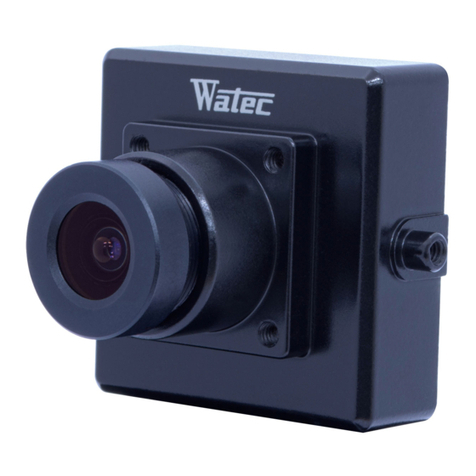
Watec
Watec WAT-230V2 User manual
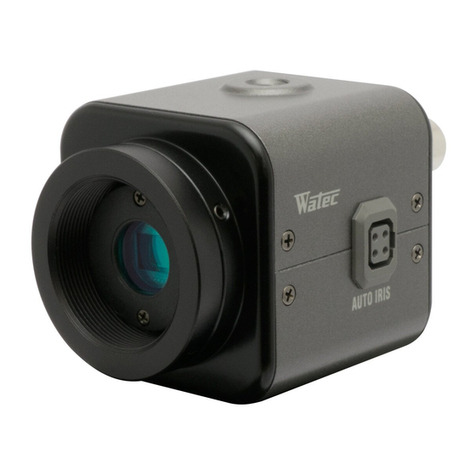
Watec
Watec WAT-221S2 User manual

Watec
Watec WAT-1100MBD User manual

Watec
Watec WAT-2200 Installation manual
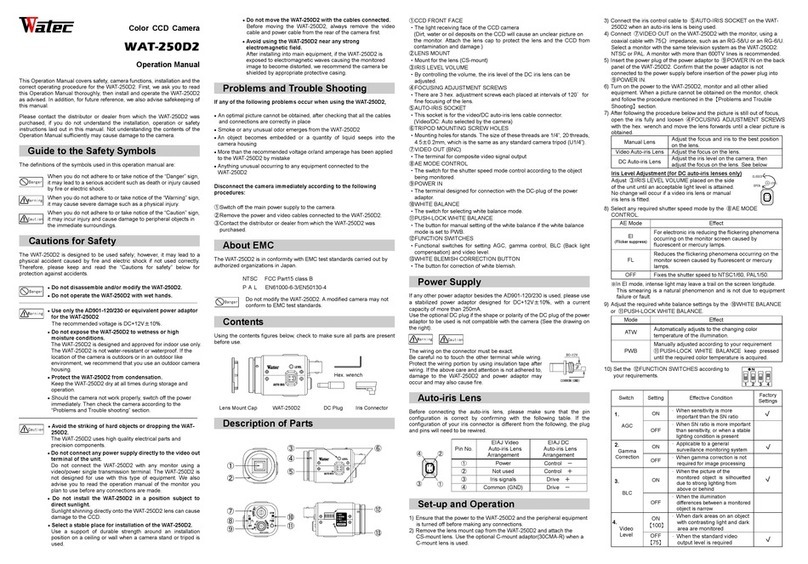
Watec
Watec WAT-250DZ Installation manual
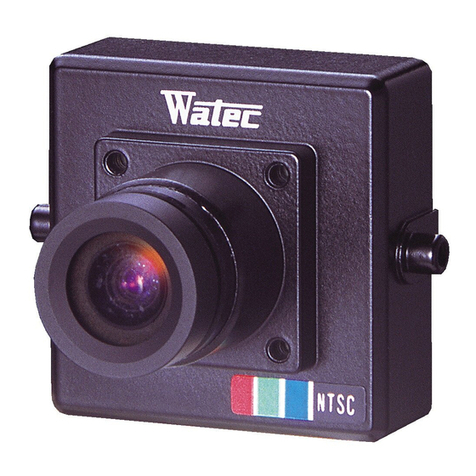
Watec
Watec WAT-230 VIVID User manual
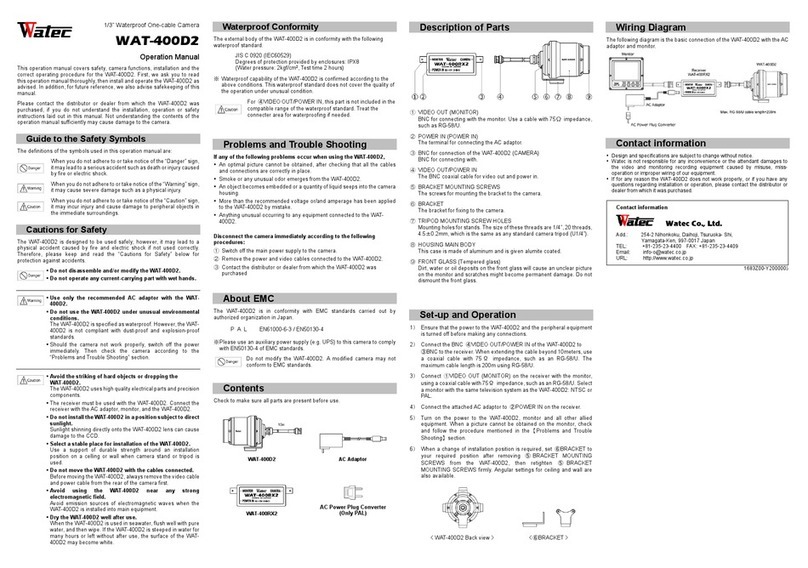
Watec
Watec WAT-400D2 User manual
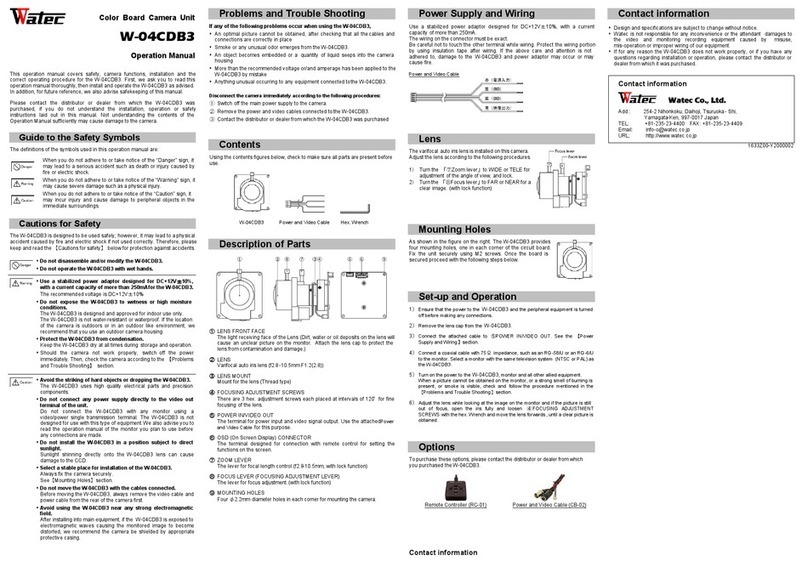
Watec
Watec W-04CDB3 User manual
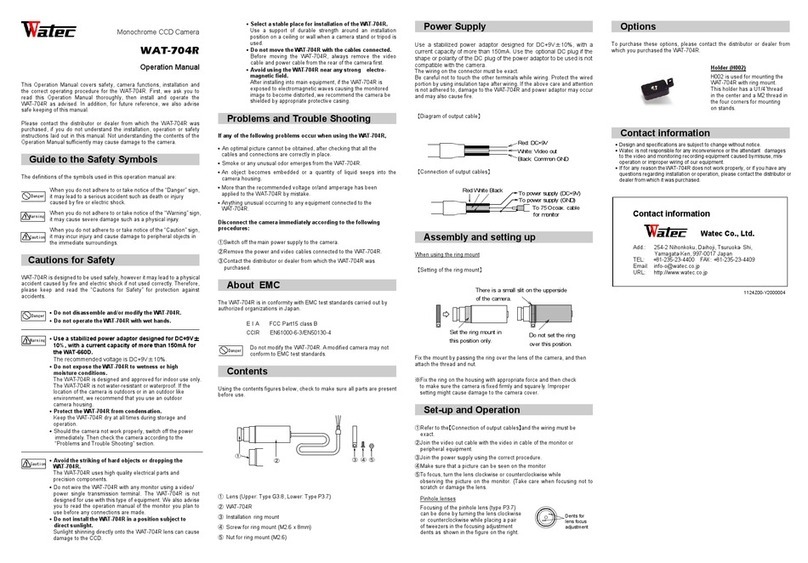
Watec
Watec WAT-704R User manual
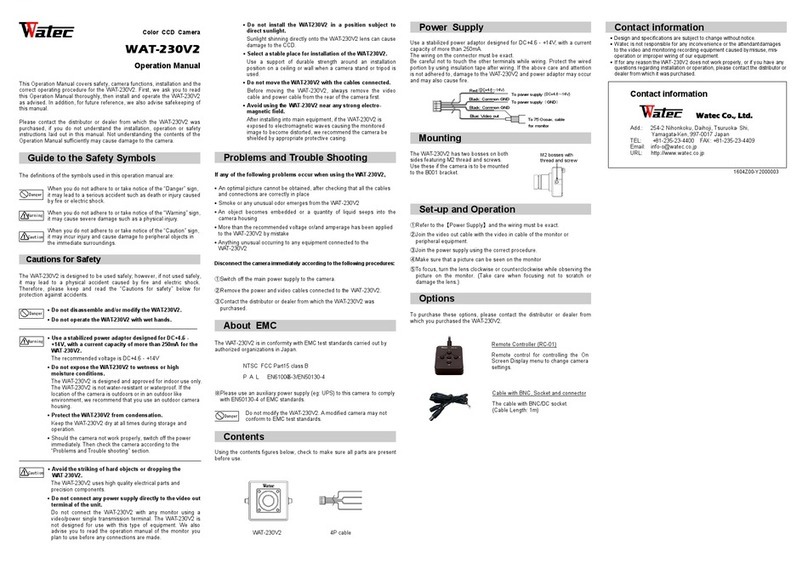
Watec
Watec WAT-230V2 Installation manual
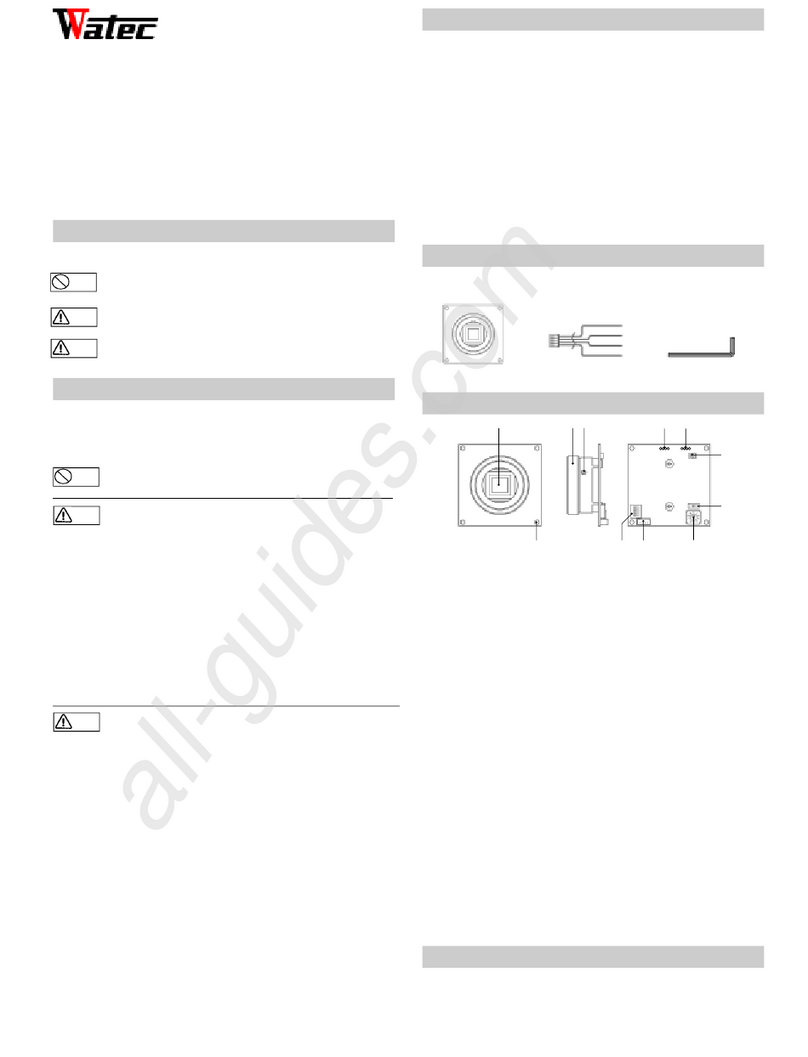
Watec
Watec W-01CDB3 User manual
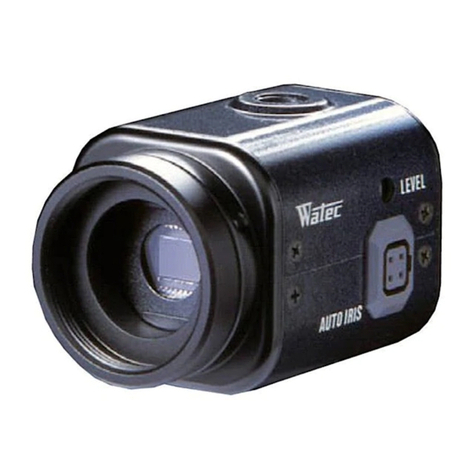
Watec
Watec WAT-902B User manual
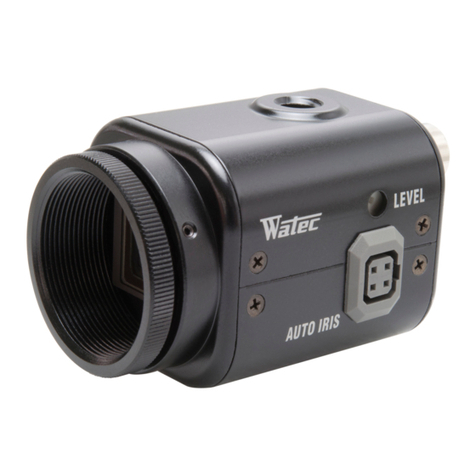
Watec
Watec WAT-910HX/RC User manual
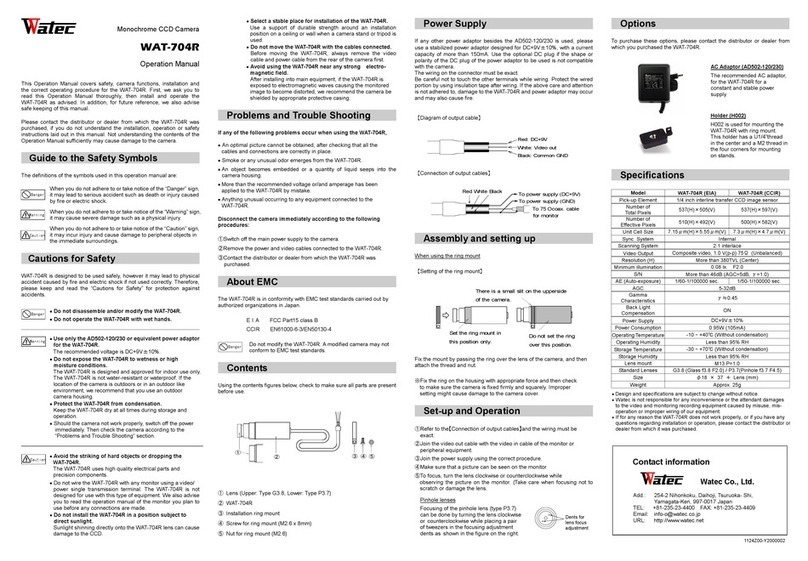
Watec
Watec WAT-704R EIA User manual
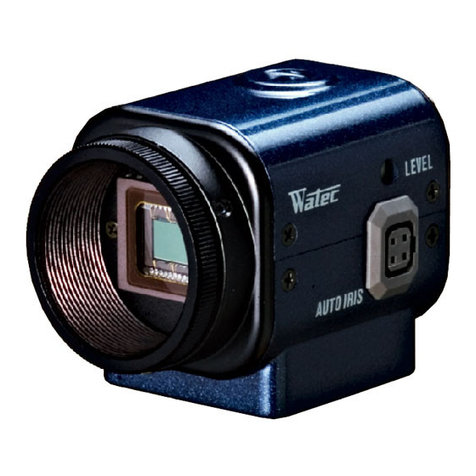
Watec
Watec WAT-902H User manual
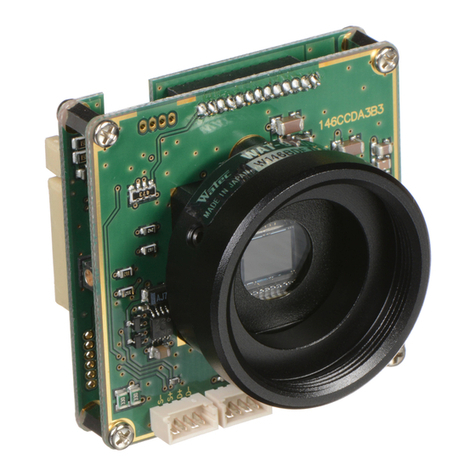
Watec
Watec WAT-910BD User manual

Watec
Watec WAT-233 User manual

Watec
Watec WAT-910BD User manual
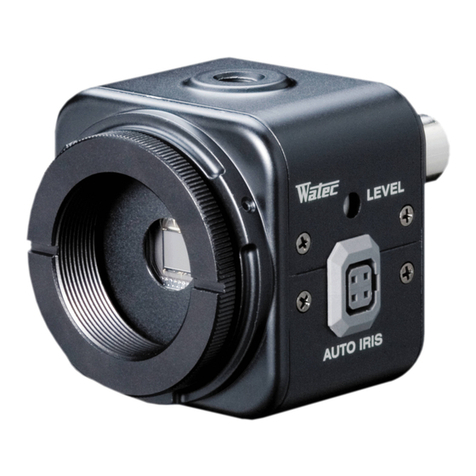
Watec
Watec WAT-525EX2 Installation manual
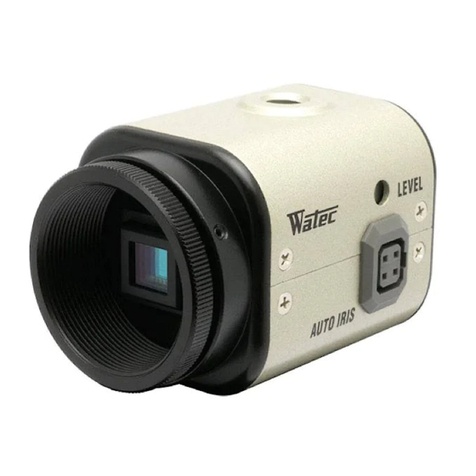
Watec
Watec WAT-2400S User manual
